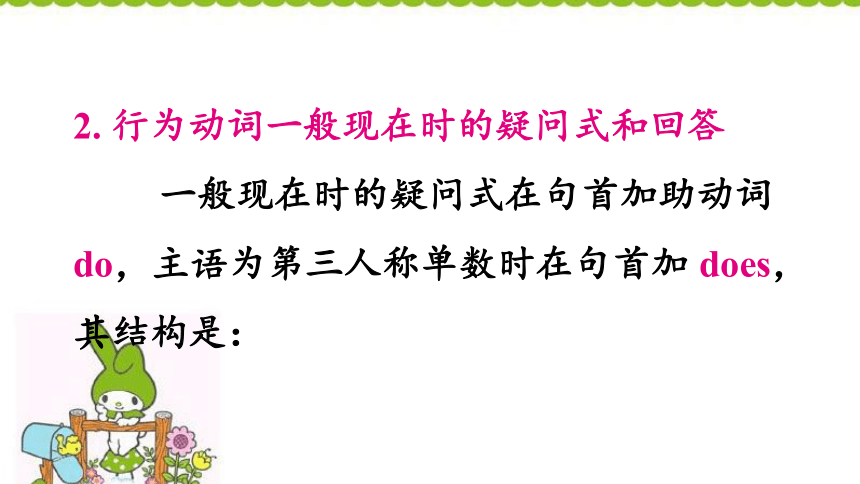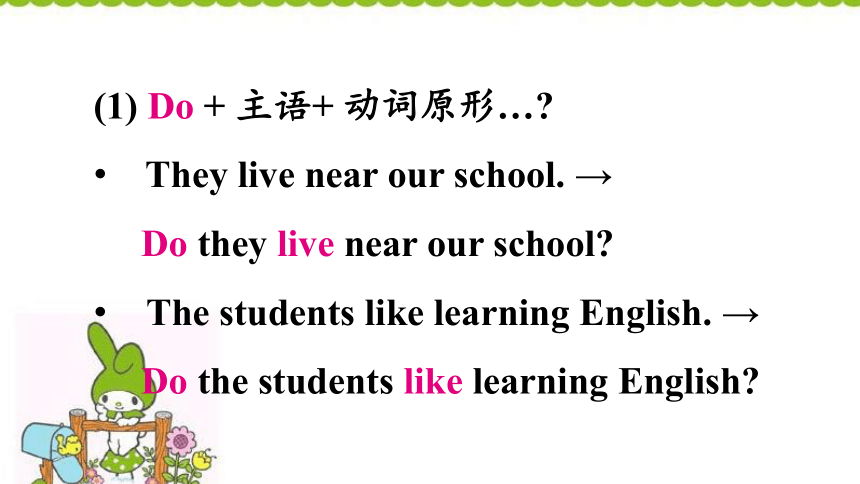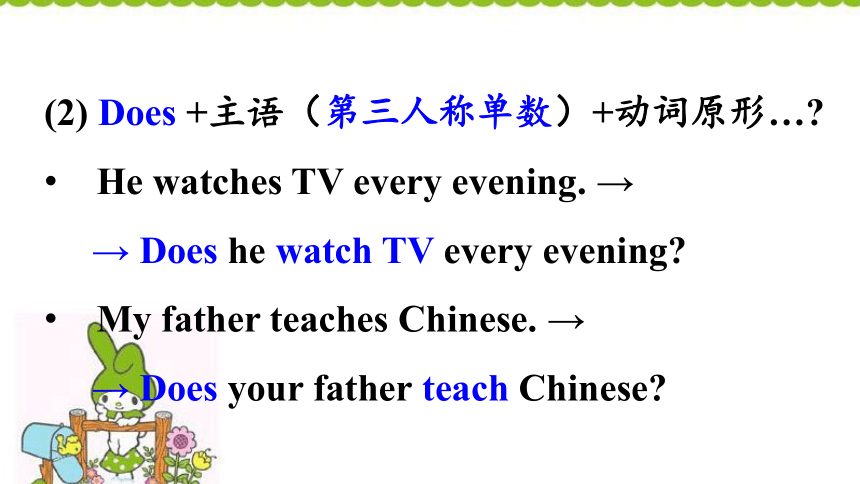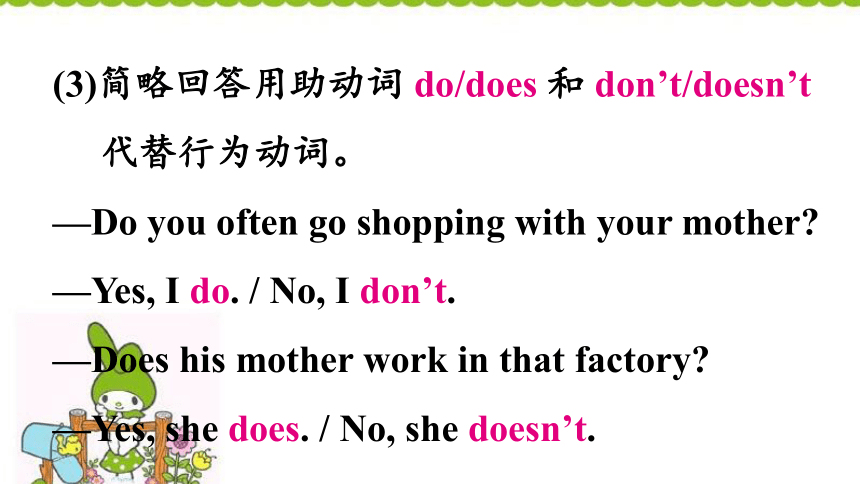Module 6 A trip to the zooUnit 3 Language in use 课件(28张PPT)
文档属性
| 名称 | Module 6 A trip to the zooUnit 3 Language in use 课件(28张PPT) |  | |
| 格式 | ppt | ||
| 文件大小 | 6.1MB | ||
| 资源类型 | 试卷 | ||
| 版本资源 | 外研版 | ||
| 科目 | 英语 | ||
| 更新时间 | 2020-07-25 20:33:20 | ||
图片预览









文档简介
外研·七年级上册
Unit 3 Language in use
Module 6 A trip to the zoo
Language practice
It doesn’t eat meat.
The tiger lives in Asia.
Does it eat meat?
No, it doesn’t. It eats plants.
1. 实义(行为)动词一般现在时的否定形式
一般现在时的否定式在动词前加 do not (don’t),主语为第三人称单数时在动词前加 does not (doesn’t),其结构是:
Grammar
(1) 主语+ do not (don’t) +动词原形…,如:
They live near our school. →
They don’t live near our school.
You like learning history. →
You don’t like learning history.
(2) 主语(第三人称单数)+ does not (doesn’t)
+ 动词原形…
He watches TV every evening. →
He does not (doesn’t) watch TV every evening.
2. 行为动词一般现在时的疑问式和回答
一般现在时的疑问式在句首加助动词 do,主语为第三人称单数时在句首加 does,其结构是:
(1) Do + 主语+ 动词原形…?
They live near our school. →
Do they live near our school?
The students like learning English. →
Do the students like learning English?
(2) Does +主语(第三人称单数)+动词原形…?
He watches TV every evening. →
→ Does he watch TV every evening?
My father teaches Chinese. →
→ Does your father teach Chinese?
(3)简略回答用助动词 do/does 和 don’t/doesn’t
代替行为动词。
—Do you often go shopping with your mother?
—Yes, I do. / No, I don’t.
—Does his mother work in that factory?
—Yes, she does. / No, she doesn’t.
肯定
否定
疑问
回答
He speaks English well.
He does not (doesn’t) speak English well.
Does he speak English well?
Yes, he does.
No, he doesn’t.
She lives in the city.
She does not (doesn’t) live in the city.
Does she live in the city?
Yes, she does.
No, she doesn’t.
The dog likes apples.
The dog does not (doesn’t) like apples.
Does the dog like apples?
Yes, it does.
No, it doesn’t.
Summary:行为动词第三人称的句式
A. 用所给动词的适当形式填空:
1. He ________ TV every evening. (watch)
2. We always _____ to school by bike. (go)
3. His uncle usually _______ to work. (walk)
4. I always ______ up at six in the morning. (get)
5. John ______ like his father. (look)
watches
go
walks
get
looks
Exercise
B. 按要求改写下列句子:
1. He likes watching TV. (改为否定句)
________________________________.
2. She has lunch at twelve. (改为否定句)
________________________________.
3. Mike does his homework at six. (改为否定句)
________________________________.
He doesn’t like watching TV
She doesn’t have lunch at twelve
Mike doesn’t do his homework at six
4. Jack likes Chinese food very much.
(改为一般疑问句,并作肯定回答)
__________________________________
__________________________________
5. He usually goes to school at 7:30.
(改为一般疑问句,并作否定回答)
__________________________________
__________________________________
Does Jack like Chinese food very much?
Yes, he does.
Does he usually go to school at 7:30?
No, he doesn’t.
C. 综合填空:
Welcome to Guangzhou Zoo. There are many kinds of a______(1), such as bears, z_____(2), giraffes and pandas. They come from many different c________(3) and they eat different food. The lion comes from E______(4).
nimals
ebras
ountries
urope
They e___(5) other animals. Does the tiger come from Europe? No, it d______(6). It comes from Asia. The e________(7) comes from the Africa, and it doesn’t like to eat m____(8). Would you like to go to see Lingling? It is a p______(9). She lives in China and she eats b_______(10).
at
oesn’t
lephant
eat
anda
amboo
1 Work in pairs. Look at the pictures.
Ask and answer.
Name: Meimei
From: Yunnan, China
Favourite food: fruit
—Does Meimei the
elephant come from
Yunnan, China?
—Yes, it does.
Name: Kingba
From: Asia
Favourite food: meat
— Does Kingba the tiger come from America?
— No, it doesn’t. It comes from Asia.
— What is Kingba’s favourite food?
— Meat.
Complete the sentences with does or doesn’t.
1 — ______ this panda come from China?
— Yes, it ______.
2 — ______ this panda eat fish?
— No, it ______.
Does
Does
does
doesn’t
3 — ______ this monkey like fruit?
— Yes, it ______.
4 — ______ this monkey live in Africa?
— No, it ______.
5 The zebra ______ like meat.
Does
Does
does
doesn’t
doesn’t
3 Complete the passage with the correct
form of the words in brackets.
My favourite animals (1) _____ (be) zebras. Look at this one. It (2) _____ (be) cute. It (3) _____ (be) black and white like the panda. But it (4) _______ (do not) come from Asia. It (5) ______ (come)
from Africa. It (6) ______ (eat) grass.
are
is
is
doesn’t
comes
eats
4 Complete the word map.
The word
of animals
Asia
giraffe
Europe
America
Africa
elephant
zebra
monkey
monkey
panda
elephant
tiger
monkey
Around the world
Camels
The camel lives in the deserts of Africa and Asia and eats grass. Some people think it carries water in the humps on its back, but it’s not true. In fact, it’s fat.
事实上,实际上
Kangaroos
The kangaroo is an Australian animal. It eats grass and leaves, but it doesn’t eat meat. It carries its babies in a pocket on the front of its body. With its strong tail and back legs, the kangaroo jumps across the grassland.
Love animals
Module task
Making a poster of your favourite animal
5 Work in groups. Find out about an animal.
Talk about your favourite animal.
Choose one animal to write about.
Find out about the animal.
It’s
big/small/tall, black and white/…
It comes from
Asia/Africa/…
It eats
meat/grass/bamboo/…
Make a poster about your group’s animal.
7 Present your poster to the class.
Draw it or find a photo.
Write some information about it.
Unit 3 Language in use
Module 6 A trip to the zoo
Language practice
It doesn’t eat meat.
The tiger lives in Asia.
Does it eat meat?
No, it doesn’t. It eats plants.
1. 实义(行为)动词一般现在时的否定形式
一般现在时的否定式在动词前加 do not (don’t),主语为第三人称单数时在动词前加 does not (doesn’t),其结构是:
Grammar
(1) 主语+ do not (don’t) +动词原形…,如:
They live near our school. →
They don’t live near our school.
You like learning history. →
You don’t like learning history.
(2) 主语(第三人称单数)+ does not (doesn’t)
+ 动词原形…
He watches TV every evening. →
He does not (doesn’t) watch TV every evening.
2. 行为动词一般现在时的疑问式和回答
一般现在时的疑问式在句首加助动词 do,主语为第三人称单数时在句首加 does,其结构是:
(1) Do + 主语+ 动词原形…?
They live near our school. →
Do they live near our school?
The students like learning English. →
Do the students like learning English?
(2) Does +主语(第三人称单数)+动词原形…?
He watches TV every evening. →
→ Does he watch TV every evening?
My father teaches Chinese. →
→ Does your father teach Chinese?
(3)简略回答用助动词 do/does 和 don’t/doesn’t
代替行为动词。
—Do you often go shopping with your mother?
—Yes, I do. / No, I don’t.
—Does his mother work in that factory?
—Yes, she does. / No, she doesn’t.
肯定
否定
疑问
回答
He speaks English well.
He does not (doesn’t) speak English well.
Does he speak English well?
Yes, he does.
No, he doesn’t.
She lives in the city.
She does not (doesn’t) live in the city.
Does she live in the city?
Yes, she does.
No, she doesn’t.
The dog likes apples.
The dog does not (doesn’t) like apples.
Does the dog like apples?
Yes, it does.
No, it doesn’t.
Summary:行为动词第三人称的句式
A. 用所给动词的适当形式填空:
1. He ________ TV every evening. (watch)
2. We always _____ to school by bike. (go)
3. His uncle usually _______ to work. (walk)
4. I always ______ up at six in the morning. (get)
5. John ______ like his father. (look)
watches
go
walks
get
looks
Exercise
B. 按要求改写下列句子:
1. He likes watching TV. (改为否定句)
________________________________.
2. She has lunch at twelve. (改为否定句)
________________________________.
3. Mike does his homework at six. (改为否定句)
________________________________.
He doesn’t like watching TV
She doesn’t have lunch at twelve
Mike doesn’t do his homework at six
4. Jack likes Chinese food very much.
(改为一般疑问句,并作肯定回答)
__________________________________
__________________________________
5. He usually goes to school at 7:30.
(改为一般疑问句,并作否定回答)
__________________________________
__________________________________
Does Jack like Chinese food very much?
Yes, he does.
Does he usually go to school at 7:30?
No, he doesn’t.
C. 综合填空:
Welcome to Guangzhou Zoo. There are many kinds of a______(1), such as bears, z_____(2), giraffes and pandas. They come from many different c________(3) and they eat different food. The lion comes from E______(4).
nimals
ebras
ountries
urope
They e___(5) other animals. Does the tiger come from Europe? No, it d______(6). It comes from Asia. The e________(7) comes from the Africa, and it doesn’t like to eat m____(8). Would you like to go to see Lingling? It is a p______(9). She lives in China and she eats b_______(10).
at
oesn’t
lephant
eat
anda
amboo
1 Work in pairs. Look at the pictures.
Ask and answer.
Name: Meimei
From: Yunnan, China
Favourite food: fruit
—Does Meimei the
elephant come from
Yunnan, China?
—Yes, it does.
Name: Kingba
From: Asia
Favourite food: meat
— Does Kingba the tiger come from America?
— No, it doesn’t. It comes from Asia.
— What is Kingba’s favourite food?
— Meat.
Complete the sentences with does or doesn’t.
1 — ______ this panda come from China?
— Yes, it ______.
2 — ______ this panda eat fish?
— No, it ______.
Does
Does
does
doesn’t
3 — ______ this monkey like fruit?
— Yes, it ______.
4 — ______ this monkey live in Africa?
— No, it ______.
5 The zebra ______ like meat.
Does
Does
does
doesn’t
doesn’t
3 Complete the passage with the correct
form of the words in brackets.
My favourite animals (1) _____ (be) zebras. Look at this one. It (2) _____ (be) cute. It (3) _____ (be) black and white like the panda. But it (4) _______ (do not) come from Asia. It (5) ______ (come)
from Africa. It (6) ______ (eat) grass.
are
is
is
doesn’t
comes
eats
4 Complete the word map.
The word
of animals
Asia
giraffe
Europe
America
Africa
elephant
zebra
monkey
monkey
panda
elephant
tiger
monkey
Around the world
Camels
The camel lives in the deserts of Africa and Asia and eats grass. Some people think it carries water in the humps on its back, but it’s not true. In fact, it’s fat.
事实上,实际上
Kangaroos
The kangaroo is an Australian animal. It eats grass and leaves, but it doesn’t eat meat. It carries its babies in a pocket on the front of its body. With its strong tail and back legs, the kangaroo jumps across the grassland.
Love animals
Module task
Making a poster of your favourite animal
5 Work in groups. Find out about an animal.
Talk about your favourite animal.
Choose one animal to write about.
Find out about the animal.
It’s
big/small/tall, black and white/…
It comes from
Asia/Africa/…
It eats
meat/grass/bamboo/…
Make a poster about your group’s animal.
7 Present your poster to the class.
Draw it or find a photo.
Write some information about it.
同课章节目录
- Starte
- Module 1 My teacher and my friends
- Module 2 My English lesson
- Module 3 My English book
- Module 4 My everyday life
- Module 1 My classmates
- Unit 1 Nice to meet you.
- Unit 2 I'm Wang Lingling and I'm thirteen years ol
- Unit 3 Language in use.
- Module 2 My family
- Unit 1 Is this your mum?
- Unit 2 These are my parents.
- Unit 3 Language in use.
- Module 3 My school
- Unit 1 There are thirty students in my class.
- Unit 2 The library is on the left of the playgroun
- Unit 3 Language in use.
- Module 4 Healthy food
- Unit 1 We've got lots of apples.
- Unit 2 Is your food and drink healthy?
- Unit 3 Language in use.
- Module 5 My school day
- Unit 1 I love history.
- Unit 2 We start work at nine o'clock.
- Unit 3 Language in use.
- Revision module A
- Module 6 A trip to the zoo
- Unit 1 Does it eat meat?
- Unit 2 The tiger lives in Asia.
- Unit 3 Language in use.
- Module 7 Computers
- Unit 1 How do I write my homework on the computer?
- Unit 2 When do you use a computer?
- Unit 3 Language in use.
- Module 8 Choosing presents
- Unit 1 I always like birthday parties.
- Unit 2 She often goes to concerts.
- Unit 3 Language in use.
- Module 9 People and places
- Unit 1 We're enjoying the school trip a lot.
- Unit 2 They're waiting for buses or trains.
- Unit 3 Language in use.
- Module 10 Spring Festival
- Unit 1 Are you getting ready for Spring Festival?
- Unit 2 My mother's cleaning our houses and sweepin
- Unit 3 Language in use.
- Revision module B
